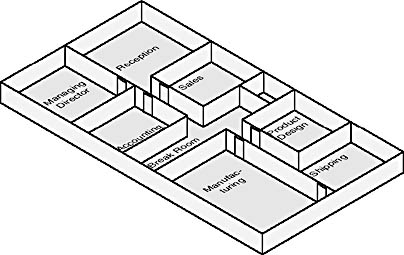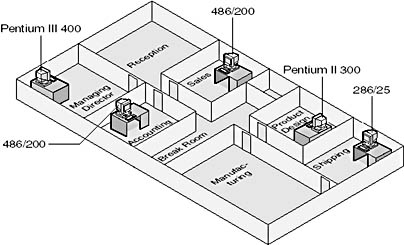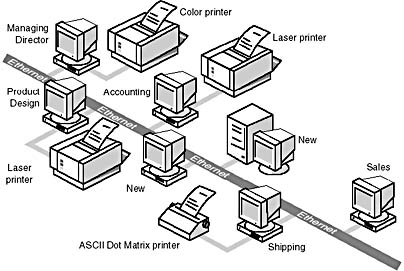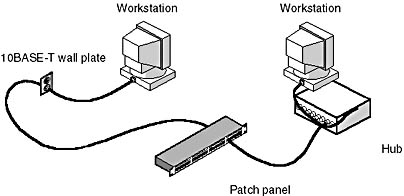Lesson 1: Choosing a Network Design
This lesson focuses on the first step in creating a computer network: laying the foundation upon which your network will be built. The decisions that you make now can make life easier for you or come back to haunt you. In this lesson, we explore the decisions and steps that you need to take to design a functional network.
After this lesson, you will be able to:
- Determine the type of network that best fits a company's needs.
- Choose the appropriate media and hardware with which to construct a successful network.
Estimated lesson time: 35 minutes
Peer-to-Peer or Server-Based?
A company that manufactures custom-made bicycles has asked you to install an economical computer network that will bring it up-to-date in communication technology and be flexible enough to allow for future expansion.
The company's network goals are to:
- Network the existing computers so that they can share information and printers.
- Add two additional computers to the network: one for the Product Design Group and one for the Manufacturing Department.
- Allow for the possible addition of three computers at a later date.
- Provide an Internet connection for the Product Design Group.
Table 8.1 provides background information about the bicycle company.
Table 8.1 Background Information on Bicycle Company
| Location | Ozona, Florida |
| Number of employees | 23 |
| Product | Custom bicycles |
| Facility | Single-story building: 245 square meters (2625 square feet) |
| Current number of computers | Five personal computers, distributed as follows: Managing Director: Pentium III 400 MHz Accounting Dept.: 486/200 MHz Sales Dept.: 486/200 Shipping Dept.: 286/25 Product Design Group: Pentium II 300 |
| Operating systems | Managing Director and Product Design Group: Windows 98 Accounting and Sales Depts.: Windows 95 Shipping Dept.: MS-DOS 5.0 |
| Peripheral equipment | The Managing Director has a modem, Internet connection, and a color ink jet printer. The Design Dept. has an old laser printer. The Accounting and Sales Depts. share a second old laser printer on a switch box. The Shipping Dept. has a dot matrix printer. |
Figure 8.1 illustrates the layout of the bicycle company, including public areas, department offices, and manufacturing facilities.

Figure 8.1 Facility layout of bicycle company
NOTE
Throughout the lessons in this chapter, we will build, maintain, and expand this hypothetical computer network. As we work through the lessons, we will discuss various applications and choose those best suited for the needs of our fictional bicycle company. Keep in mind that the choices we make are based on the requirements of this hypothetical company and will not address every company's networking situation and needs.
The first decision we need to make for this new network is whether it should be a peer-to-peer or a server-based network. The factors we need to examine include the:
- Size of the network.
- Level of security.
- Type of business.
- Level of administrative support available.
- Amount of network traffic.
- Needs of the network users.
- Network budget.
In a peer-to-peer network, all users on the network are equal. Each will have equal access to all other computers on the network, provided the owner of the computer has shared that resource with the network. In a small network or business, this "one for all and all for one" system often works well.
Often, in a small business, no individual is able to devote full-time attention to administering the network. This brings another advantage of peer-to-peer networks to light. Here, responsibility for running the network is distributed to everyone, and users determine which information or resources on their computers will be shared.
While the peer-to-peer network option looks like a good choice for our bicycle company, it has some drawbacks that must be considered. For example, imagine a user on the network who has the laser printer attached to her computer. If she turns off her computer and leaves the office, no one else will be able to use the printer. If Computer A freezes or is rebooted while Computer B is trying to use a resource, Computer B will be disconnected. To summarize, usually, in a peer-to-peer scenario, no system administrator is designated, security precautions are few, and each user is responsible for his or her own data.
Another down side of the peer-to-peer network is its limited performance. If another user is accessing the resources on your computer, that user will also be using processor time on your computer. Therefore, regardless of how fast your computer's processor is or how much memory you have, the performance of your computer will slow down when someone else is drawing on its resources.
Even with these drawbacks, a peer-to-peer network might still appear to be a good choice for our network. However, we should also consider the advantages of using a server-based network before we make our decision. On a server-based network, resources are usually centralized. For example, one server manages all the printers, and another server manages all the files. Because servers are rarely turned off, resources will always be available. Server-based networks are also scalable. This means that their size can be easily adjusted to respond to changes in the load on the network.
Server-based networks are also more secure than peer-to-peer networks. With a peer-to-peer network, all resources are shared equally across the network. If the Accounting Department shares the directory that contains the salary files so that the Managing Director can access them, everyone else on the network can also access these files. On the other hand, server-based networks allow for the creation of accounts and permissions that provide for further security. For example, a server-based network can share individual files within a directory without making the directory itself available to everyone on the network.
As it grows, a server-based network can be segregated according to organizational needs. For example, one server might be designated for the Accounting Department and another server designated for the Sales Department. Should our bicycle company's network requirements reach this level, we will need to consider using a network that supports file-level sharing and user groups with shared rights to network resources.
At present, the better choice for our company is to use a peer-to-peer network. But in order to provide more flexibility and to prepare it for further expansion, another option exists: create a hybrid network. Thus, while our basic network will be peer-to-peer, we will install one computer as a file server. With this approach, access to the file server requires an account and permissions, while access to other computers on the network is shared equally.
So, after weighing these factors, we arrive at our network-design selection for this bicycle company: a hybrid peer-to-peer network, with one new computer to be installed and configured as a file server and used to centralize company information.
Taking Inventory
After deciding on the overall network design, our next step in creating a network is to take inventory to determine what hardware and software is already available and what needs to be acquired. As an illustration, we turn again to our bicycle company. It has a mixture of computers, ranging from a legacy 286 to a new Pentium III, as well as some older printers. Thus, some obvious updating will be required to get this network up and running. Taking inventory is an important step, because it sets the stage for future network expansion. For example, if all your computers run Microsoft Windows 95 or Windows 98, you will be limited to using a peer-to-peer network. To upgrade to a server-based network in the future, you will have to upgrade one of the computers to run NetWare or Windows NT or add a new server with one of those network operating systems installed.
To take inventory, you'll need to survey four categories:
- Hardware
- Software
- Telecommunications equipment
- Network requirements
Hardware Survey
This is actually a simple process, but one that should not be taken lightly. Begin by recording the specifications of each computer; the details you gather at this stage can save time in the long run. As we will see later, in order to function effectively, networks often require that hardware and software meet certain minimum standards. If you know the specification details of the available equipment in advance, you can prevent many problems later on.
For each computer, you will need to gather information, including:
- Make and model.
- Processor manufacturer and speed.
- Amount of memory (RAM) installed.
- The size and manufacturer of each hard drive.
- Details of any other installed drives, such as compact-disc and removable disk drives.
- Monitor—make, model, and size.
- Video card—make, model, and amount of memory.
- Any installed peripherals.
- Type of bus—EISA, Micro Channel, ISA, or PCI—the computer uses and whether there are any free slots; you will need free slots to install network interface cards. (For more information on bus architecture, refer to Lesson 2: The Network Interface Card, in Chapter 2.)
Make a list of the manufacturer and model number for any peripheral devices, such as printers, plotters, and scanners, whether they are installed or simply sitting on a shelf. For each of these, note whether you have the original disk with drivers.
Software Survey
Be aware of all the software currently in use throughout the potential network. For example, if you were to convert all the computers to Windows NT while you were installing the new network, you might find that some of the old standby programs, once used on a daily basis, now no longer run. Be especially careful when evaluating custom-designed and proprietary programs, such as accounting databases, that have been written especially for the company. You might need to contact the manufacturer for information about running proprietary programs on the network. Not all of these will run in a network environment; the product-licensing arrangement might not allow network operations.
For each software program, gather the following information:
- Program name
- Program version number
- Availability of the original installation floppy disks or compact discs
- Any licensing information
As you carry out your survey of our bicycle company, also note any potential software incompatibilities within and among company departments. For example, the Accounting Department might be using WordPerfect, whereas the Sales Department is using Microsoft Office. If you are planning to upgrade some day, now is the time to make any changes needed to ensure that the same system is used company wide.
Telecommunications Equipment Survey
It might seem strange to review the existing telecommunications equipment when you are installing a LAN, but this is actually a very important element of your survey, especially if you intend to use Internet connections or some form of remote access server. (Known as RAS, this is a host on a LAN that includes modems and enables users to connect to the network over telephone lines; RAS is discussed in Chapter 7, Lesson 2: Connection Services.) Overlooking something as simple as the number of phone lines wired into each office can have a major impact later if you need modem and telephone connections at the same time. For example, if the company has an automated telephone system, while telephone outlets might be located in every office, they might not be capable of a modem connection. In that case, a separate telephone outlet might be required for voice and data communication. Also, if the company is using a high-speed digital telephone service, you might not be able to connect with standard modems. Don't assume a standard RJ-11 telephone jack is going to be sufficient for you to connect a modem and start surfing the Web.
Requirements of the Network
After you have examined the existing facility and equipment, you need to define the requirements of your network. You'll then match these requirements to the existing hardware, software, and telecommunications features available and determine what steps need to be taken to develop the network. At a minimum, you should consider the following:
- The size of the facility (located on a single floor vs. multiple floors)
- The number of users
- Whether the LAN will be extended to several buildings
- The environment (office, manufacturing, out-of-doors)
- The current network media, if any
- The technical competence of users
- The amount of network traffic (initially, and anticipated for the future)
- The level of security
Building a Map
Now it's time to lay out the network. But before you begin to recommend a network plan for our bicycle company, you will first need to make a map of all the elements involved. During this step, you should consider two aspects of the network: the physical layout, including the location of each piece of hardware and how it relates to the others, and the physical and logical topology of the proposed network.
Use a drawing or map of the facility—or make one if it doesn't exist already—and mark the location of the existing equipment. Figure 8.2 shows the facility drawing for the bicycle company, with the location of the existing equipment.

Figure 8.2 Existing equipment for the bicycle company
The second step is to create a layout of the network topology. Don't forget to include printers and other peripherals, such as scanners and modems. Figure 8.3 shows the company network as a physical bus.

Figure 8.3 Bicycle company network as a physical bus
Figure 8.4 Shows the network as a physical star.

Figure 8.4 Bicycle company network as a physical star
NOTE
Adequately documenting a network is the key to successful troubleshooting in the future. Start with the facility map and equipment survey.
Choosing Network Media
The choice of which media to select should not be taken lightly. The cost of installation can be quite high, especially if you have to do it twice. The media you choose will usually be related to the geographic requirements of the site. For example, if several of the workstations are located in a manufacturing environment in which a large amount of electrical noise is generated, fiber-optic cable might be required because it is unaffected by electrical signals. On the other hand, in a small office, simple twisted-pair cable will usually be appropriate. The most important thing to keep in mind is not the cost today, but the cost in the future. Being overly cost-conscious now can limit the scalability, and thus the life span, of the network.
At our bicycle company, we might decide to install our network using CAT 3 UTP cable. This would give us a functional network with our seven workstations, but limit our network speed to 10 Mbps. Five years from now, when we might have as many as 30 to 50 workstations, a 10 Mbps network would be slow. However, by installing CAT 5 UTP now, we can upgrade our network to 100 Mbps at any time in the future without needing to rewire the building. And CAT 5 UTP cable costs only a few cents more per foot than CAT 3 UTP cable.
Installing Network Media
Installing network media requires special skills and is best left to a professional cable installer if the topology is complex. With a simple topology, however, the necessary skills are well within our reach. Still using our bicycle company as an example, we will next tackle the basics of installing a CAT 5 Ethernet cabling system. (Bear in mind that at this point we are focusing on the cables and are not yet ready to connect any of the devices.)
The simplest way to lay out a network in our small-office environment is to use a physical star. The focal point of the star will be a patch panel. (A patch panel is an array of RJ-45 female connectors that have terminals for connecting the wires.) Figure 8.5 shows a typical 12-connection CAT 5 568B patch panel.

Figure 8.5 12-connection CAT 5 568B Patch Panel
Notice that the front of the panel has 12 RJ-45 connectors. On the back is a terminal for each of the 12 cables. Looking closely, you will notice that each terminal has eight connection points, one for each of the eight wires. The wires are color-coded for easy installation. By mounting the patch panel near the hub (usually next to the server), you can easily make connections to the network.
On the other end of the cable, you will need to install a CAT 5 outlet. This is similar to a standard telephone outlet (see Figure 8.6), but uses an RJ-45 connection, just as the patch panel does. Notice that this connector also has color-coded terminals.

Figure 8.6 CAT 5 outlet
NOTE
Some CAT 5 outlets have two sets of color coding, one for 568A and one for 568B cable termination. Be sure to match the color code of the outlet and the patch panel.
Remember that when installing the cable, as discussed in Chapter 2, "Basic NetworkMedia," any cables that are to be run above the ceiling or below the floor must meet local construction and fire codes. Be sure to use plenum-grade cable where it is required.
If you plan to install a lot of cable and connections (patch panels or CAT 5 outlets), you might want to purchase a punch down tool. (This is a small hand tool that will ensure that the wires are properly connected to the terminal.) Figure 8.7 shows a typical punch down tool.

Figure 8.7 Punch down tool
Connecting Media to Computers
Once the media is installed, connecting the computers is straightforward. All connections are made through CAT 5 patch cables (prewired cables and connectors, in a variety of solid colors). One end of the cable is secured to the computer's NIC and the other to the RJ-45 outlet. If you are using a hub, you will find that short patch cables connect the patch panel and an outlet on the hub. Don't worry if you find that there is no computer connected to an outlet and the cabling is connected all the way to the hub. The hub will sense that the segment is unoccupied and ignore it. Figure 8.8 shows a hub connected to a patch panel and a workstation.

Figure 8.8 Installed media

Exercise 8.1: Creating a Peer-to-Peer Network
In this exercise, your task is to prepare a design of the network for our bicycle company. All the information you need to refer to is provided in this lesson. This exercise is presented in two parts. First define the topology to use, and second, make a list of materials required.
Part 1: Design a Topology
Because peer-to-peer Ethernet can be implemented in the form of either a physical bus or a physical star, you will need to look at these two different topologies in planning for this network. On separate paper, draw:
- A logical bus with a physical bus.
- A logical bus with a physical star.
Check your drawings against the answer figures for this exercise in Appendix A.
Answers
Part 2: Select Your Materials
Make a materials list for each of the topologies. Using the facility drawing provided earlier in Figure 8.1, identify the location of each workstation and estimate all the materials you will need to complete the job. Use the following table to help determine which materials are required.
Material Requirements
| Logical bus; physical bus | Logical bus; physical star | |
|---|---|---|
| Type of cable | ||
| Length of cable | ||
| Connectors (type and count) | ||
| Terminators | ||
| Patch cables | ||
| Patch panel | ||
| Hub |
Save your work to use later in Exercise 2, which follows Lesson 2: Establishing a Client/Server Environment, in which we will build on the physical star logical bus design you have begun to build in this exercise.
Answers
Lesson Summary
The following points summarize the main elements of this lesson:
- The first step in network design is to decide whether the network will be peer-to-peer or server-based.
- Take a detailed inventory of all the available networking hardware, software, and telecommunications equipment on hand, before recommending any equipment purchases for a new LAN.
- Create a map of the facility layout and the network (logical and physical) as the beginning of your network-documentation package.
- Installing network media is difficult, and complex configurations require a professional installer. Basic installations can be accomplished without professional assistance.
- By knowing the specifics of each piece of hardware that will be on the network, you can map a network design and foresee potential problems.
- Addressing potential problems before implementing the network can save time and expense.
EAN: 2147483647
Pages: 106